选修6unit5 grammar 现在分词作状语
- 格式:pptx
- 大小:436.13 KB
- 文档页数:41
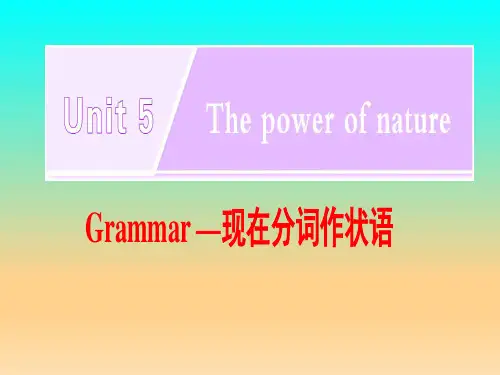
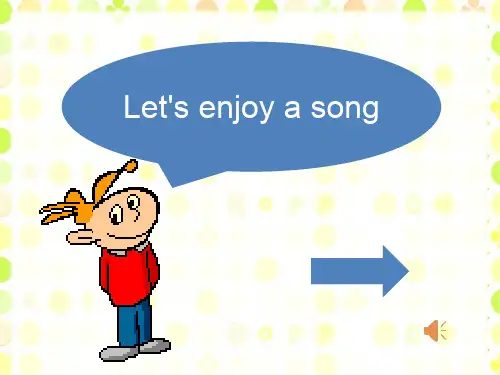
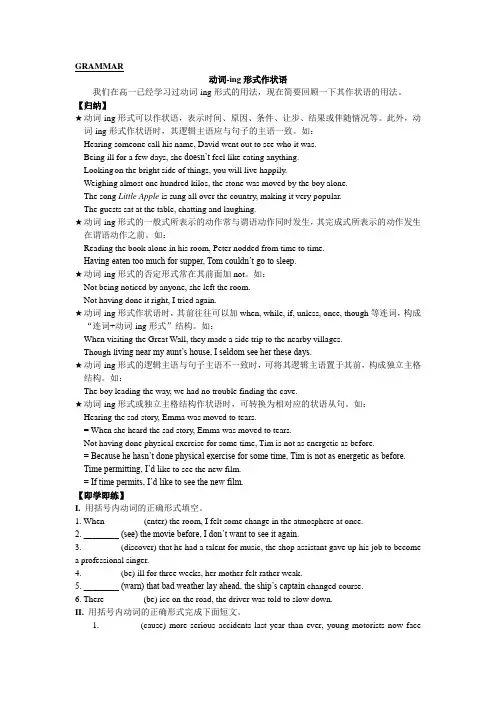
GRAMMAR动词-ing形式作状语我们在高一已经学习过动词-ing形式的用法,现在简要回顾一下其作状语的用法。
【归纳】★动词-ing形式可以作状语,表示时间、原因、条件、让步、结果或伴随情况等。
此外,动词-ing形式作状语时,其逻辑主语应与句子的主语一致。
如:Hearing someone call his name, David went out to see who it was.Being ill for a few days, she doesn’t feel like eating anything.Looking on the bright side of things, you will live happily.Weighing almost one hundred kilos, the stone was moved by the boy alone.The song Little Apple is sung all over the country, making it very popular.The guests sat at the table, chatting and laughing.★动词-ing形式的一般式所表示的动作常与谓语动作同时发生,其完成式所表示的动作发生在谓语动作之前。
如:Reading the book alone in his room, Peter nodded from time to time.Having eaten too much for supper, Tom couldn’t go to sleep.★动词-ing形式的否定形式常在其前面加not。
如:Not being noticed by anyone, she left the room.Not having done it right, I tried again.★动词-ing形式作状语时,其前往往可以加when, while, if, unless, once, though等连词,构成“连词+动词-ing形式”结构。
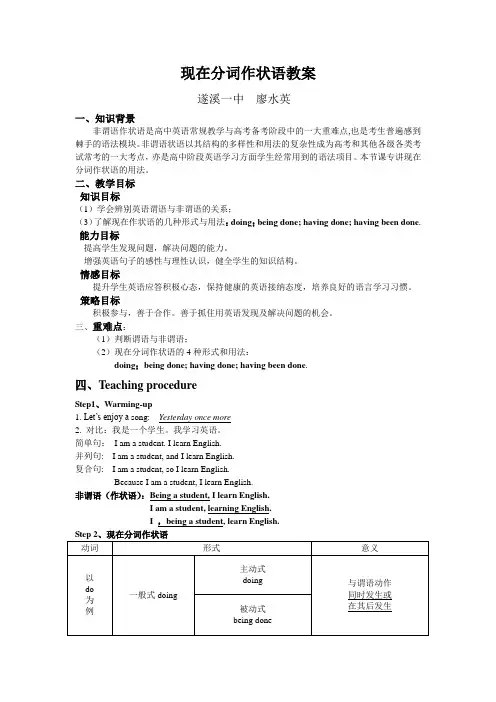
现在分词作状语教案遂溪一中廖水英一、知识背景非谓语作状语是高中英语常规教学与高考备考阶段中的一大重难点,也是考生普遍感到棘手的语法模块。
非谓语状语以其结构的多样性和用法的复杂性成为高考和其他各级各类考试常考的一大考点,亦是高中阶段英语学习方面学生经常用到的语法项目。
本节课专讲现在分词作状语的用法。
二、教学目标知识目标(1)学会辨别英语谓语与非谓语的关系;(3)了解现在作状语的几种形式与用法:doing;being done; having done; having been done. 能力目标提高学生发现问题,解决问题的能力。
增强英语句子的感性与理性认识,健全学生的知识结构。
情感目标提升学生英语应答积极心态,保持健康的英语接纳态度,培养良好的语言学习习惯。
策略目标积极参与,善于合作。
善于抓住用英语发现及解决问题的机会。
三、重难点:(1)判断谓语与非谓语;(2)现在分词作状语的4种形式和用法:doing;being done; having done; having been done.四、Teaching procedureStep1、Warming-up1. Let’s enjoy a song: Yesterday once more2. 对比:我是一个学生。
我学习英语。
简单句:I am a student. I learn English.并列句: I am a student, and I learn English.复合句: I am a student, so I learn English.Because I am a student, I learn English.非谓语(作状语):Being a student, I learn English.I am a student, learning English.I ,being a student, learn English.)Heating the metal, we can see the metal expands.2)Being heated ,the metal expands.(“加热”和“膨胀”两个动作同时发生)3)Having finished the homework, he went to play basketball.(先完成功课,然后再打篮球。
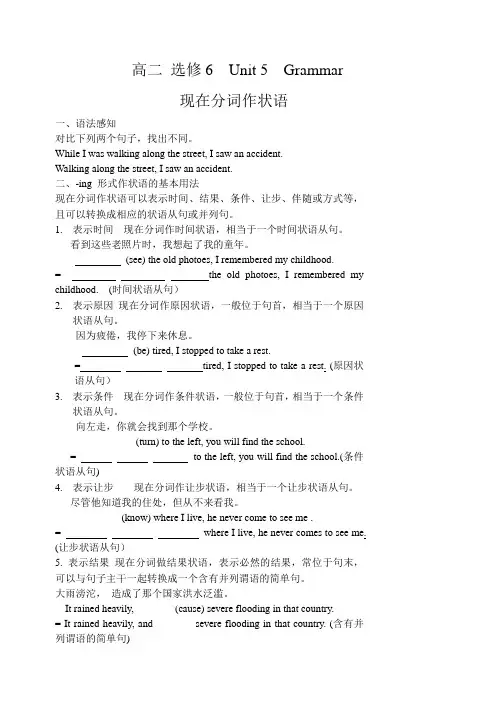
高二选修6 Unit 5 Grammar现在分词作状语一、语法感知对比下列两个句子,找出不同。
While I was walking along the street, I saw an accident.Walking along the street, I saw an accident.二、-ing 形式作状语的基本用法现在分词作状语可以表示时间、结果、条件、让步、伴随或方式等,且可以转换成相应的状语从句或并列句。
1.表示时间现在分词作时间状语,相当于一个时间状语从句。
看到这些老照片时,我想起了我的童年。
(see) the old photoes, I remembered my childhood.= the old photoes, I remembered my childhood. (时间状语从句)2.表示原因现在分词作原因状语,一般位于句首,相当于一个原因状语从句。
因为疲倦,我停下来休息。
(be) tired, I stopped to take a rest.= tired, I stopped to take a rest. (原因状语从句)3.表示条件现在分词作条件状语,一般位于句首,相当于一个条件状语从句。
向左走,你就会找到那个学校。
__________ (turn) to the left, you will find the school.= to the left, you will find the school.(条件状语从句)4.表示让步现在分词作让步状语,相当于一个让步状语从句。
尽管他知道我的住处,但从不来看我。
__________(know) where I live, he never come to see me .= where I live, he never comes to see me. (让步状语从句)5. 表示结果现在分词做结果状语,表示必然的结果,常位于句末,可以与句子主干一起转换成一个含有并列谓语的简单句。
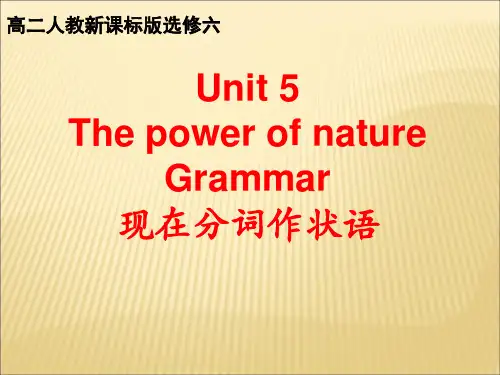
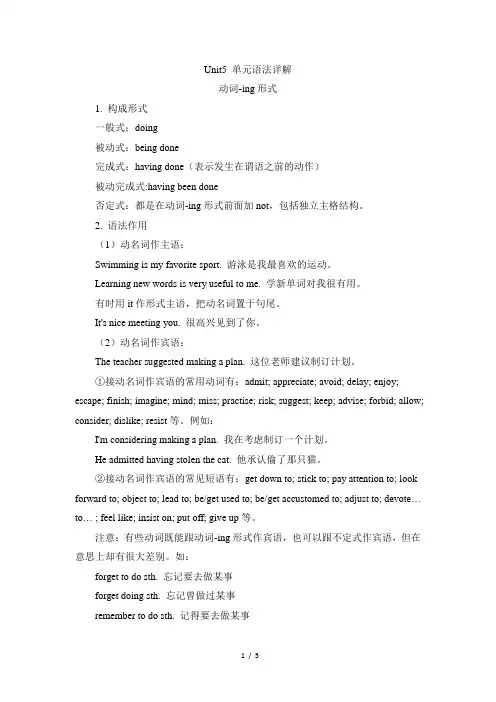
Unit5 单元语法详解动词-ing形式1. 构成形式一般式:doing被动式:being done完成式:having done(表示发生在谓语之前的动作)被动完成式:having been done否定式:都是在动词-ing形式前面加not,包括独立主格结构。
2. 语法作用(1)动名词作主语:Swimming is my favorite sport. 游泳是我最喜欢的运动。
Learning new words is very useful to me. 学新单词对我很有用。
有时用it作形式主语,把动名词置于句尾。
It's nice meeting you. 很高兴见到了你。
(2)动名词作宾语:The teacher suggested making a plan. 这位老师建议制订计划。
①接动名词作宾语的常用动词有:admit; appreciate; avoid; delay; enjoy; escape; finish; imagine; mind; miss; practise; risk; suggest; keep; advise; forbid; allow; consider; dislike; resist等。
例如:I'm considering making a plan. 我在考虑制订一个计划。
He admitted having stolen the cat. 他承认偷了那只猫。
②接动名词作宾语的常见短语有:get down to; stick to; pay attention to; look forward to; object to; lead to; be/get used to; be/get accustomed to; adjust to; devote…to… ; feel like; insist on; put off; give up等。

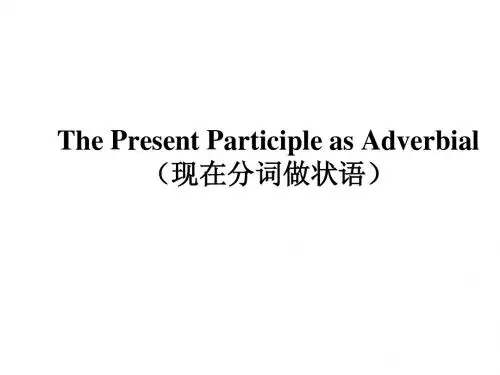
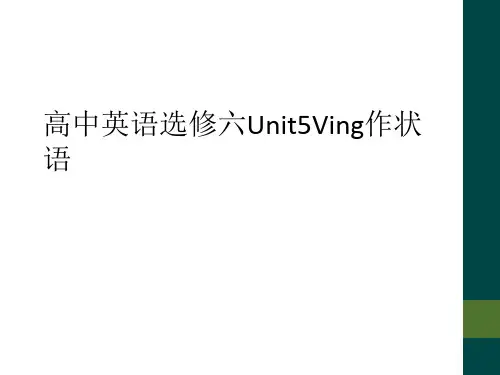
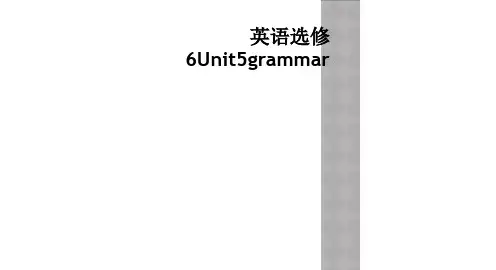
高二选修6 Unit 5 Grammar教案预习学案1. Review the usage of –ing form below. Examine the sentences and discuss in what way the structures similar to each other and in what way they are different.1)Looking carefully at the ground, I made my way to the edge of the crater.2)Having experienced quite a few earthquakes in Hawaii already, I didn’t take much notice.区别:探究学案-ing 形式的用法1)–ing 形式作状语1 Walking along the street, I met Mary.= While I was walking along the street, I met Mary.(时间状语从句)在街上走的时候,我遇到了玛丽。
2 Being tired, I stopped to take a rest.=Because I was tired, I stopped to take a rest. (原因状语从句)因为疲倦,我停下来休息。
3 Turning to the left, you will find the school.= If you turn to the left, you will find the school.(条件状语从句)向左走,你就会找到那个学校。
4 Knowing where I live, he never come to see me .= Though he knows where I live, he never comes to see me. (让步状语从句)尽管他知道我的住处,但从不来看我。